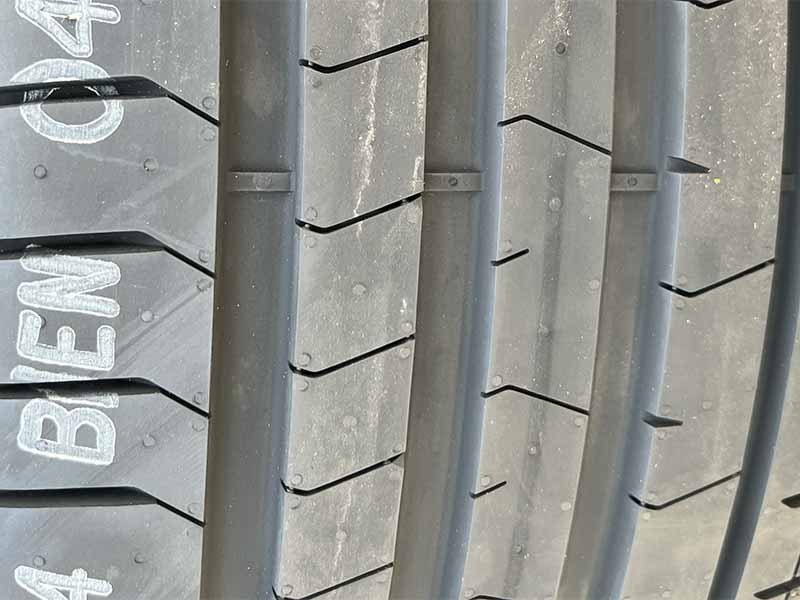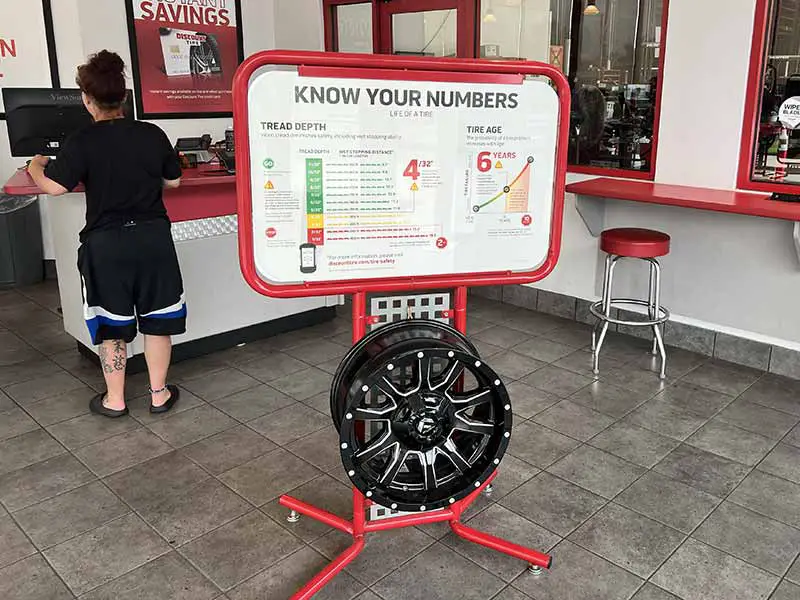Everyone wants to get the most value they can out of their tires, but what is the lowest tread depth that is still safe for driving on wet roads?
Passenger cars and light truck tires are expensive. Replacing them unnecessarily can be a waste of money, but safety is more important than saving a couple of bucks.
How Much Tire Tread Is Safe?
Tires are no longer considered safe once the tread depth has reached 2/32″. This is the point at which they will not pass an inspection and require replacement.
It is often suggested that you replace your tires at 4/32″ or 3/32″ to improve stopping distance on wet roads and help reduce the chance of hydroplaning.
The actual point that you feel most comfortable with the wet weather performance of your tires is what’s important. The legal minimum depth can be scary when panic braking.
Let’s take a closer look.
Tire Tread Depth Chart & Calculator
Braking Distance In Rain & Tire Tread Depth
Tire tread depth is what allows your tire to channel water away from under your tires and allow it to grip the road surface. As your tire tread wears down you gradually lose braking performance on wet roads.
The difference between new tires and worn tires’ stopping distance can be staggering. You don’t often notice the difference until you’re in an emergency braking situation, and then it can sometimes be too late.
The design of tread ribs and grooves in tread patterns can have some effect on overall performance, but if there is no tread depth left, your tires are essentially bald and the water underneath them has nowhere to go.
Is 5/32 Tread Bad?
5/32″ of tread depth is a good tire tread depth but it is getting close to the point that tires need to be replaced.
This average tread depth is approximately the halfway point between a new tire’s tread depth and one that is considered bald.
Braking performance in wet conditions will be much longer than that of new tires, but it is still reasonably good at this depth. I would not recommend replacing evenly worn tires with this amount of tread left.
Is 4/32 A Tread Safe?
4/32″ tire tread depth is still well within the legal limits but the stopping distance compared to new tires will have increased approximately 100 feet at 70 mph on wet roads.
Some conservative drivers that often deal with rainy conditions and standing water may find this tread depth a good point to have their tires replaced.
Tread depths below this are still legal and common, but wet weather driving will be much less safe.

Is 3/32 Tire Tread Safe?
3/32″ of tire tread depth is just above the legal limit and acceptable, but your tire’s grip in the rain will be dramatically reduced at this point.
Differences in tread depth on newer tires make very little difference, but as your tires wear down to lower tread depths, braking performance becomes exponentially worse. The braking distance between a new tire and 4/32″ is significant. The reduction in safety between 4/32″ and 3/32″ could be as much as half again the entire reduction of 4/32″.
In other words, it may take nearly 50% longer to come to a complete stop than if you had an extra 1/32″ of extra tire tread wear.
Is 2/32 Tire Tread Dangerous?
2/32″ is the minimum legal tread depth but is actually quite risky. While technically the legal limit, tires slowly lose the ability to channel water out from under the contact patch as they wear down.
Tires grip better in wet weather conditions if they have more tread depth to work with. Once your tire tread is only 2/32″ deep, there is a very little area left for water to flow out from under the tire tread and it is extremely difficult for the tires to find any traction.
2/32″ is the point that you should be replacing tires as soon as possible. Most tire shops and mechanics will highly recommend replacing your tires before they wear down to this low tire tread depth.

What Is The Minimum Amount Of Tread Your Tires Need?
While the legal limit is 2/32″ of tread depth, you can dramatically increase the stopping distance in wet conditions by replacing your tires before this low tread depth.
4/32″ or 3/32″ are lower tread depths that will both tire performance in wet conditions over 2/32″, but still allow you to get sufficient tread life and value for your dollar out of your tires.
Minimum Tire Tread Depth For Winter Driving Conditions
Winter tires require much more tread depth to have a good grip in snowy conditions. Snow and slush don’t flow like water and as easily channel out from under the tire tread.
For better performance and safety on snow-covered roads, you should make sure you maintain a tread depth of at least 5/32″ to have enough tread to keep stopping distance and traction within a safe driving range.
Winter tires use a softer rubber compound that is able to remain flexible in extremely cold weather conditions. The tire treads can still flex and grip the road surface properly due to this.
However, this rubber isn’t designed to deal with the heat and hot weather that summer tires or all-season tires can handle. The tread blocks will flex too much in warmer temperatures making them perform poorly. They will also wear much more quickly, making your expensive winter tires worthless in a short period of time.
Only use winter tires when the temperatures are below 40º F outside. Temperatures above this point will be unsafe to use these tires and ruin them quickly.
Tire Tread Wear Indicator (Wear Bars)
Most tires will come with wear indicator bars or some similar design embedded into their tread patterns. Wear bars are usually slightly elevated rubber bars in the main grooves of the tread patterns.
As your tires wear down, the outer surface of the tire comes closer and closer to becoming even with the top of the wear bar. Once the outer surface of the tire matches the level of the indicator bars, you know that your tires have reached the maximum allowable wear and need to be replaced as soon as possible.

How To Measure Tread Depth
The depth of tread is measured in increments of 1/32″ here in the United States. 11/32″ to 10/32″ is common on a new tire while the minimum acceptable depth is 2/32″.
Measuring the remaining tread on your tires is fairly straightforward. You insert a measuring device into the main grooves of the tire treads and measure the distance from the bottom of the groove to the top of the tread block. The distance between these two points is the measured remaining depth.
Using A Tread Depth Gauge
Gauges for measuring tread come in various shapes and sizes, but most include a probe that descends to the bottom of the tread groove and a stop bar that rests on top of the tread block. The distance the probe travels is the measure of the remaining tread wear.
These gauges will have increments that indicate the wear level in the 32nd of an inch or millimeters.
Using The Penny Test
The penny test is a convenient method for checking the depth of your tread when you don’t have a gauge available.
The penny test is designed to only give you a reasonable idea of where 2/32″ and 4/32″ are and how your tread compares to those measurements.
If the top of your tread block doesn’t touch the top of Abraham Lincoln’s Head when inserted between the tread blocks upside down, you’ve reached or exceeded the minimum limit and need to have your tires replaced as soon as possible.
If the top of the tread block is between the top of Lincoln’s head and his forehead, you should consider buying new tires soon. The closer the top of the tread block is to the top of Lincoln’s head, the closer you are to the limit and need to get new tires mounted immediately.
If the top of the tread blocks or tread ribs are touching Lincoln’s forehead or anywhere further down his head when inserted upside down in the tread groove you know you have plenty of tread wear left before you need to be concerned.
Uneven Treadwear
Uneven tread wear across the surface of your tire’s tread can reduce the overall ability of your tires to deal with water on paved surfaces. While you may have sufficient tread left on some areas of your tire, if the whole tire doesn’t have enough depth, you essentially have the limited performance of the lowest section of tread.
To avoid uneven treadwear you should be sure to check your air pressure monthly, rotate your tires every 5,000 miles, rebalance your tires, and have your alignment checked every 10,000 miles.
Resources
Below are some links you may find helpful when learning about tires
Final Thoughts
Just because 2/32″ is the legal minimum allowable tread wear level doesn’t mean that everyone should push all the way down to that point. A little extra safety margin, especially for those that more frequently deal with heavy rain and standing water makes a lot of sense.
When you compare the added length required to come to a complete stop with each extra bit of tread worn away, you may decide to be a bit more conservative and not try to squeeze every penny you can out of your tires.
Good luck and happy motoring.








